2. What Is Mental Health and Wellness?
This section describes what mental health is and focuses on what mental wellness looks like by introducing the Wellness Wheel, a model based on Indigenous holistic perspectives of wellness. The Wellness Wheel is available as a PDF (Handout 1).
These slides are available for use with this section of the presentation. For information about downloading the slide deck, see the Introduction.
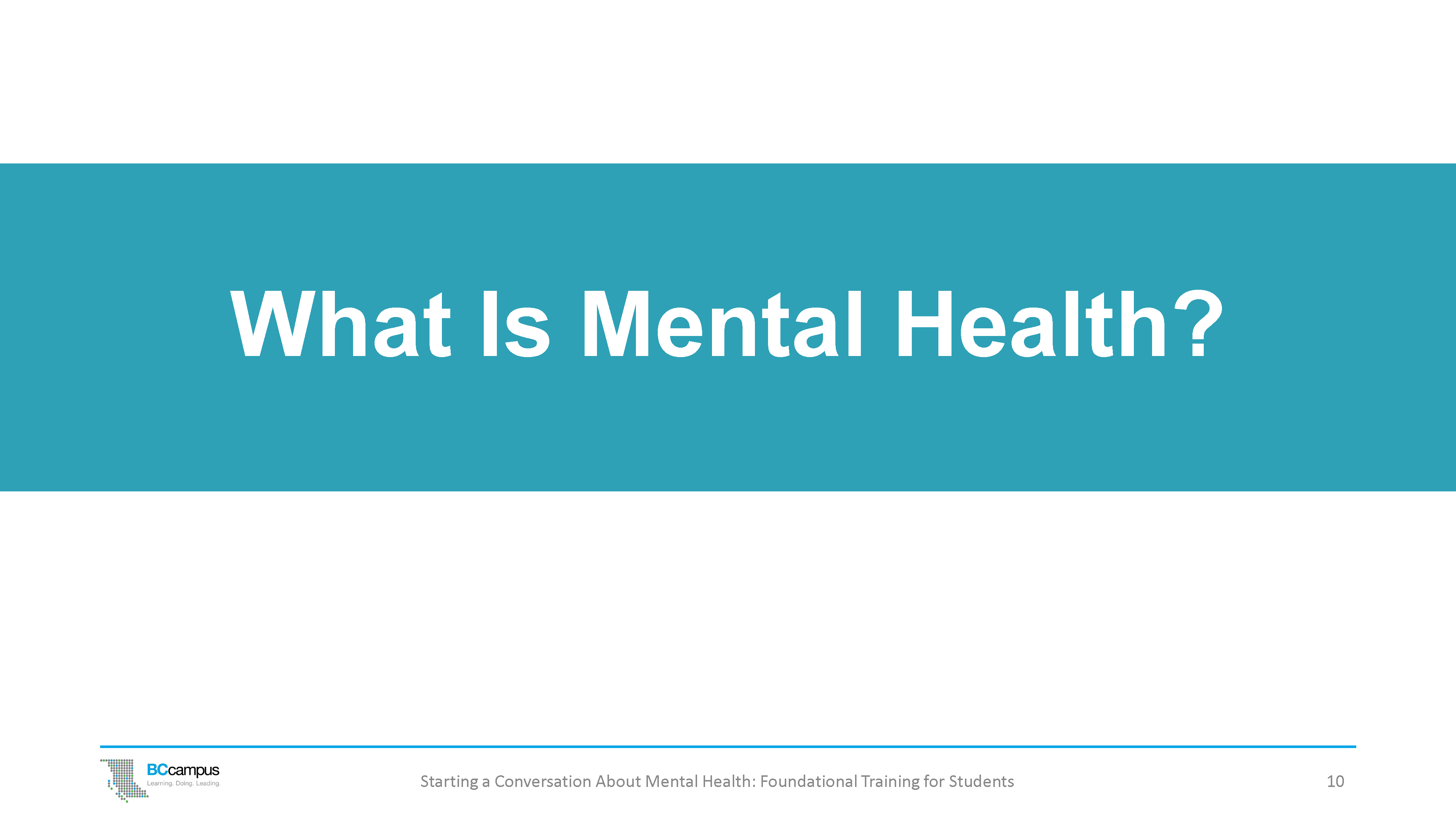
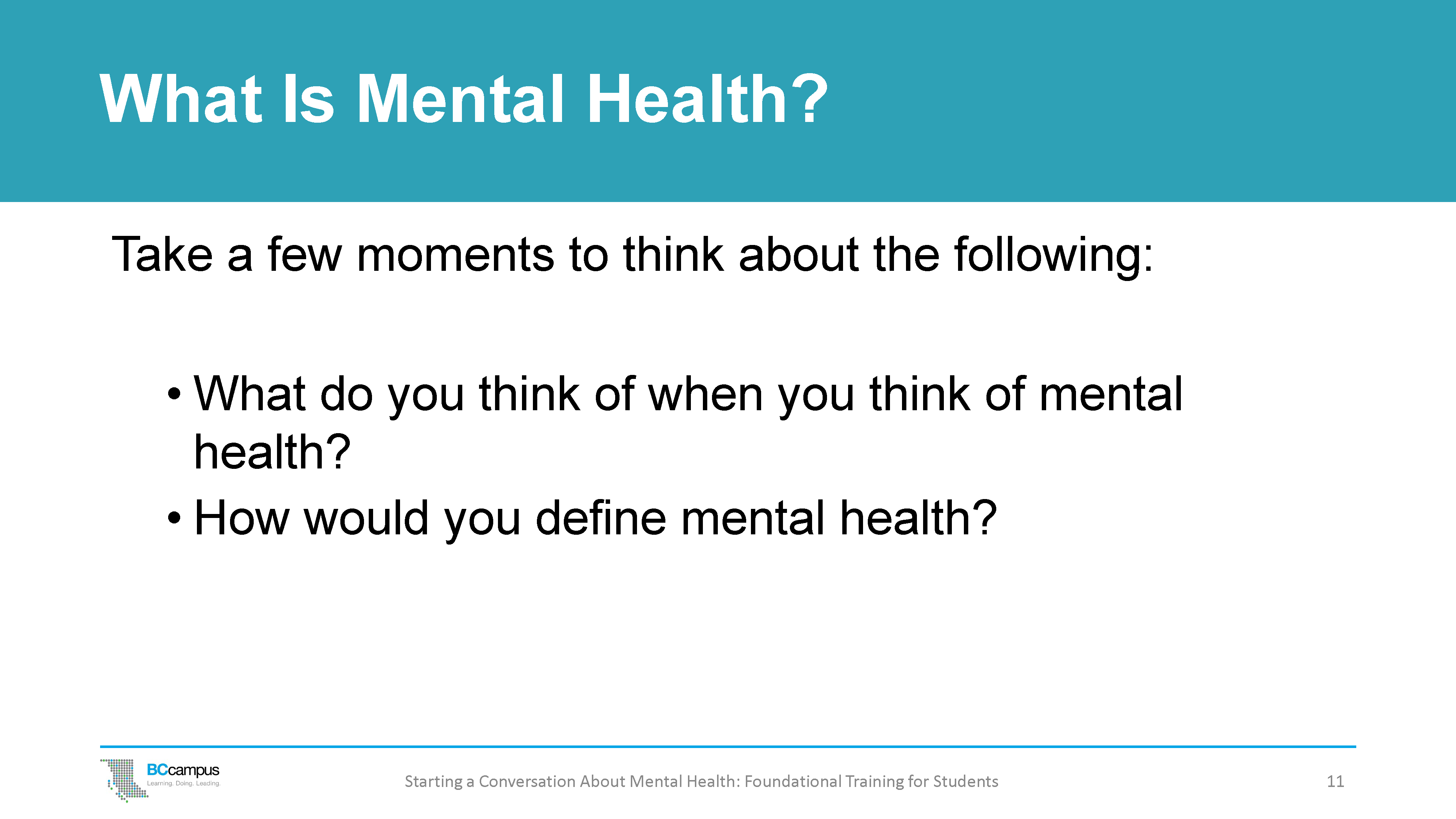
ACTIVITY: Brainstorming What Mental Health Means
Ask participants to jot down what they think of when they think of mental health. (If online, ask participants to put one or two thoughts in the chat.) Ask participants to briefly share, and then show the slide with the definition from the Public Health Agency of Canada.
Consider this definition of mental health:
“Mental health is the capacity of each and all of us to feel, think, and act in ways that enhance our ability to enjoy life and deal with the challenges we face. It is a positive sense of emotional and spiritual well-being that respects the importance of culture, equity, social justice, interconnections, and personal dignity.”
– Public Health Agency of Canada, 2014
This definition comes from the Public Health Agency of Canada. Are there other definitions that resonate better for you? Are there components missing?
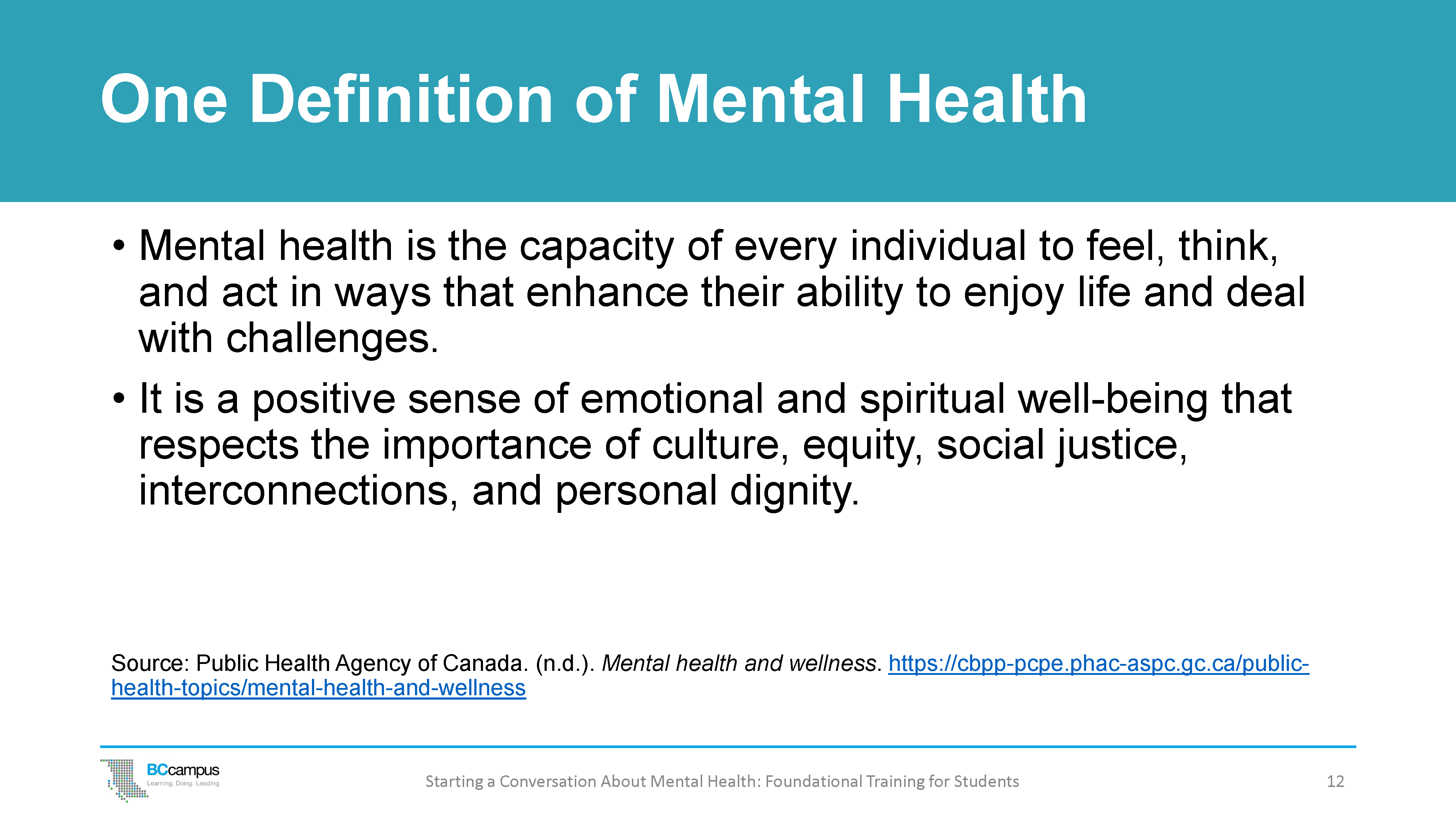
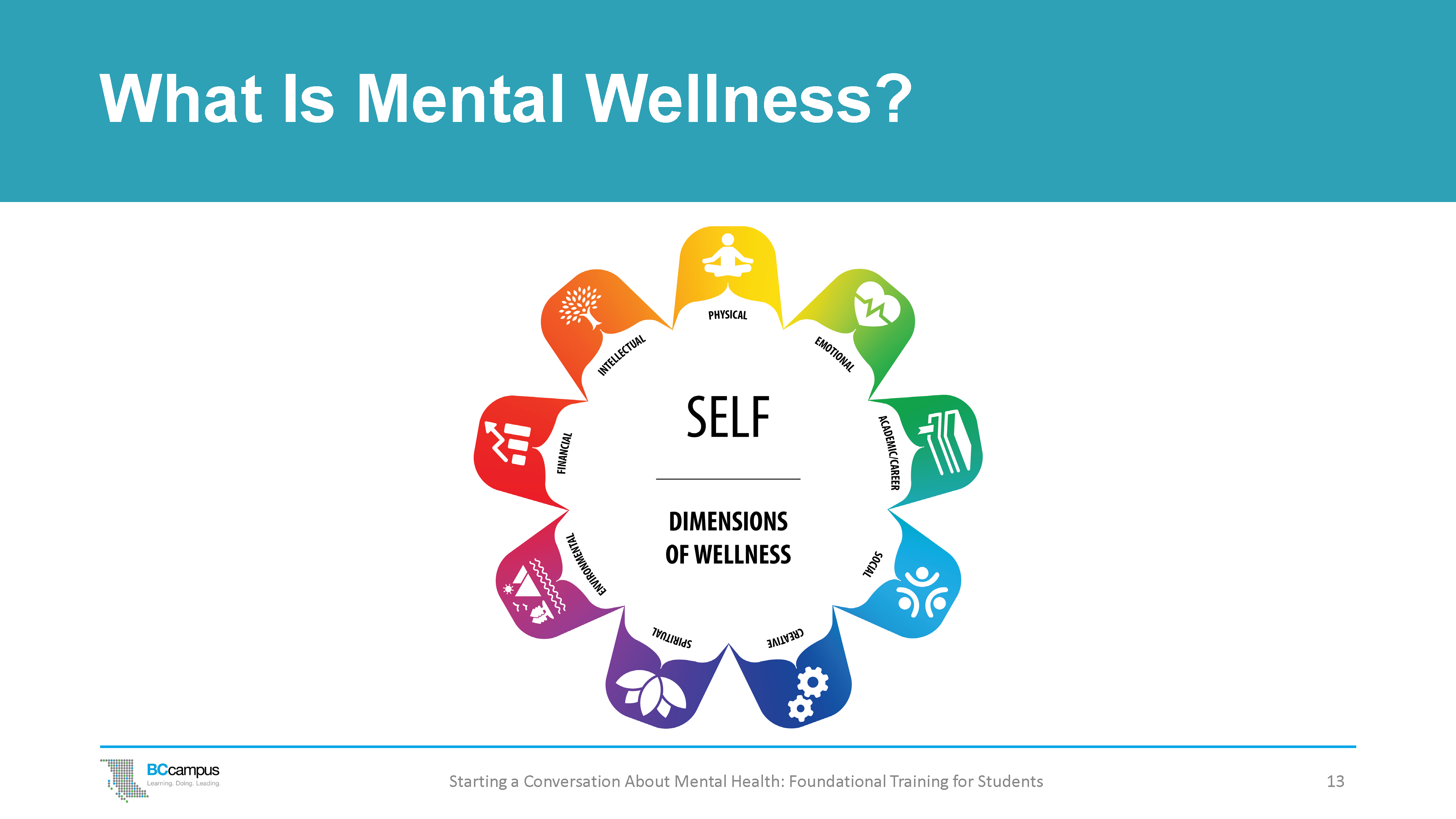
The Wellness Wheel
Let’s first look at what mental wellness looks like. The Wellness Wheel is a model that aligns with Indigenous traditional practices, which view individuals holistically. It recognizes that wellness is about being in a state of balance with the physical, emotional, academic/career, social, creative, spiritual, environmental, financial, and intellectual aspects of our lives. The Wellness Wheel can help us identify what might be causing us stress and understand what aspects might be falling in and out of balance in our lives.
The Wellness Wheel is not a static concept but a way of viewing the many dimensions that support wellness. There are things we can all do as individuals to improve our own mental health and well-being, and how we manage our wellness is an ongoing reflective practice.
The goal is not to be perfectly balanced; you will not always be able to attend to different aspects of your wellness equally. The Wellness Wheel can be used as a reflection tool to help you consider where you might want to focus some energy if you want to invest in your wellness.
We can try our best to be flexible and respond to aspects of well-being that may need additional care or attention. Using the concepts in the Wellness Wheel can help us visualize our journey and assist not only in mitigating stressful circumstances but also in recognizing areas of our lives in which we are thriving.
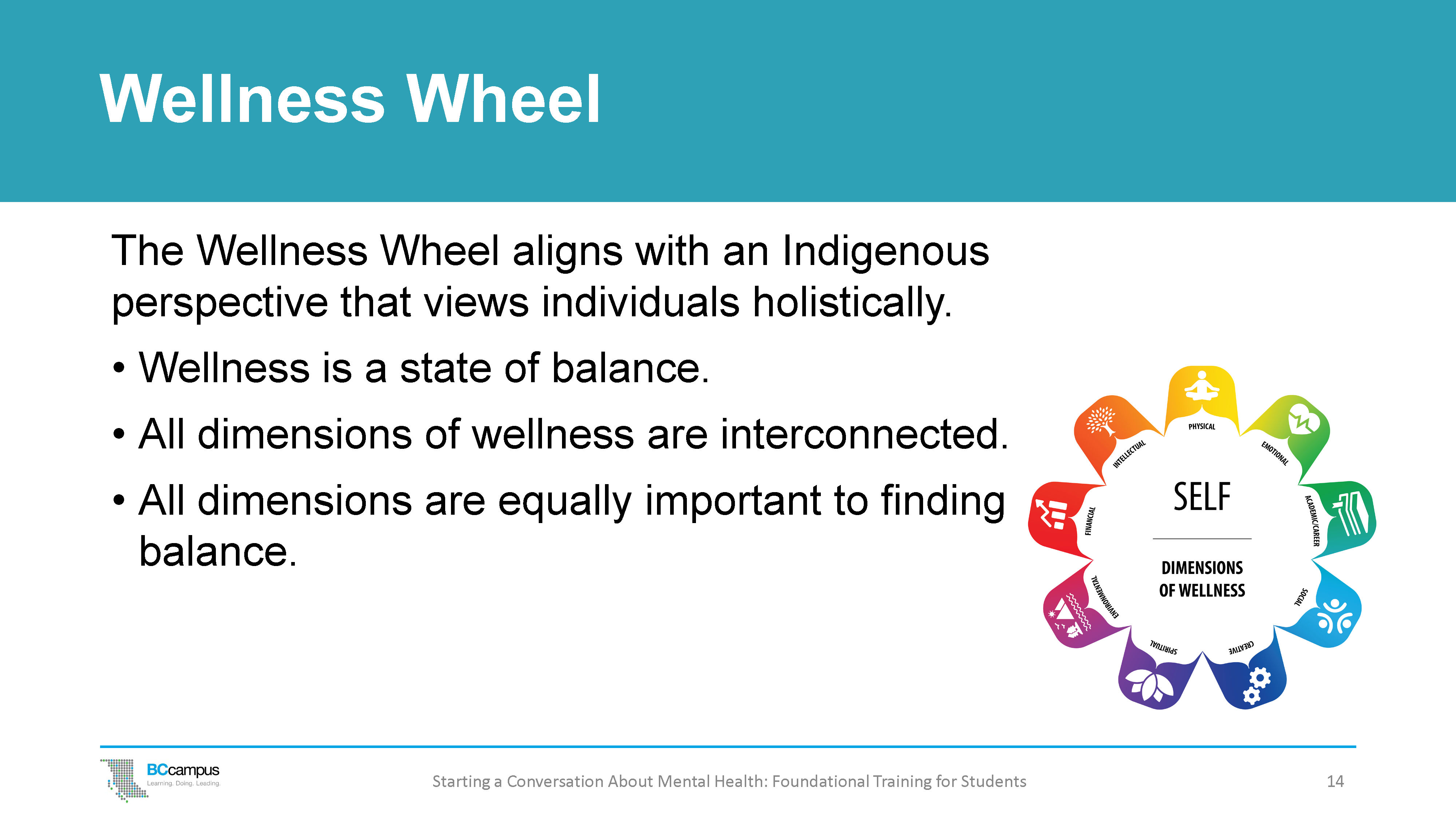
The Wellness Wheel and Dimensions of Wellness
Click on the + signs in the Wellness Wheel for more information about each of the dimensions.

The Wellness Wheel is made up of the following dimensions:
- Physical wellness
- Emotional wellness
- Academic/career wellness
- Social wellness
- Creative wellness
- Spiritual wellness
- Environmental wellness
- Financial wellness
- Intellectual wellness
Let’s look at some suggestions for taking care of different aspects of your wellness. Keep in mind that these are just suggestions, and often activities are beneficial in many different dimensions. For example, taking a walk in the park with a friend could support your physical wellness, emotional wellness, social wellness, and environmental wellness.
Physical wellness means taking care of your body through physical activity, nutrition, sleep, and mental well-being. For example:
- Engaging in some form of physical activity every day for at least 30 minutes
- Eating a variety of healthy foods
- Getting an adequate amount of sleep every night (7–9 hours)
Emotional wellness means making time to relax, reduce stress, and take care of yourself. It also means paying attention to both positive and negative feelings and understanding how to handle these emotions. For example:
- Practising mindfulness
- Starting a gratitude journal
- Paying attention to self-talk and shifting toward positive self-talk
- Tracking emotions daily to look for patterns and possible triggers
Academic/career wellness means expanding your knowledge and creating strategies to support continued learning. For example:
- Setting up academic goals
- Creating a study schedule and plan ahead
- Connecting with a mentor to further your understanding of career ideas
- Reviewing your short- and long-term career goals regularly to make sure you are on track
Social wellness means taking care of your relationships and society by building healthy, nurturing, and supportive relationships and fostering a genuine connection with those around you. For example:
- Making an effort to keep in touch with individuals who are supportive
- Practising active listening skills
- Joining a club or an organization to meet new people
- Being mindful of commitments you make – know your limitations (don’t spread yourself too thin)
Creative wellness means valuing and actively participating in arts and cultural experiences as a means to understanding and appreciating the world around you. For example:
- Playing an instrument or making music
- Engaging in the visual arts
- Trying creative writing
- Engaging in creativity through movement (e.g., dance)
Spiritual wellness means taking care of your values and beliefs and creating purpose in your life. For example:
- Volunteering
- Meditating
- Expressing gratitude
- Practising forgiveness and compassion for yourself and others
Environmental wellness means taking care of what is around you. Living in harmony with the Earth by taking action to protect it and respecting nature and all species. For example:
- Spending time in nature
- When possible, travelling by walking, riding your bike, or taking public transportation
- Recycling and composting
- Using reusable water bottles and shopping bags
Financial wellness means learning how to successfully manage your finances so you can be financially responsible and independent. For example:
- Creating and maintaining a budget
- Paying your bills on time
- Packing your lunch to limit how often you eat out
- Meal planning before grocery shopping
Intellectual wellness means being open to exploring new concepts, gaining new skills, and seeking creative and stimulating activities. For example:
- Trying a new activity at school or in the community
- Exploring things that you are curious about
- Reading and writing for pleasure
Let’s keep the Wellness Wheel in mind as we look at other mental health models. We’ll come back to the Wellness Wheel and do a group activity a bit later in the session.
Text Attributions
- This chapter is by Jewell Gillies and Barbara Johnston (CC BY 4.0 License).
- “Dimensions of the Wellness Wheel” is adapted from Okanagan College, (n.d.), Wellness peer ambassador handbook. Okanagan College (CC BY 4.0 License).
Media Attributions
- Wellness Wheel © Jewell Gillies is used under a CC BY 4.0 International license. All icons licensed as CC BY 4.0 » yoga by zidney from the Noun Project | heart rate by Naufal Hudallah from the Noun Project | Book by Studio TROISQUATRE from the Noun Project | Gears by Gregor Cresnar from the Noun Project | Lotus by Brad Avison from the Noun Project | landscape by Creative Stall from the Noun Project | forest by Creative Stall from the Noun Project | Sea Sunset by Creative Stall from the Noun Project | Park by Creative Stall from the Noun Project | gaining by Alice Design from the Noun Project | Tree by Brian Hurshman from the Noun Project.

